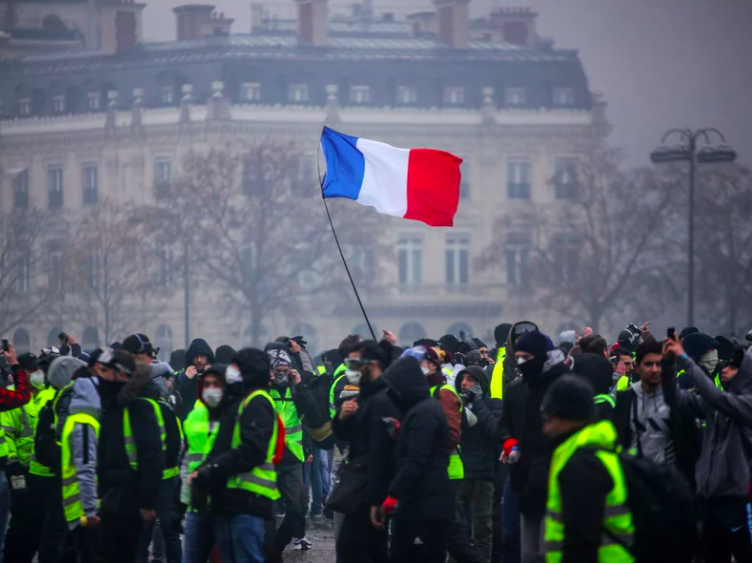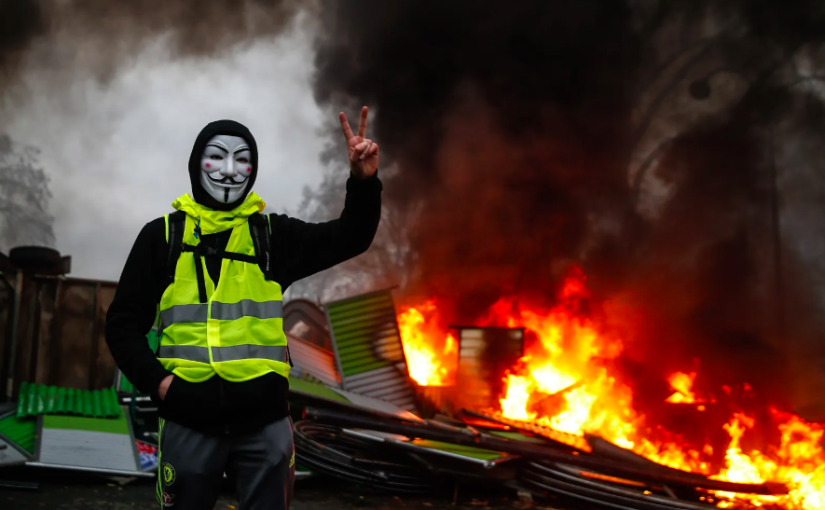The “Gilets Jaunes” movement is assumed to have been the biggest challenge to Emmanuel Macron’s presidency in 2018. Starting in early November of the same year, ‘Gilets Jaunes (yellow vests) were the cause of a social uprising and political crisis in France regarding the unjust tax policies, the lack of democracy and the abuse of power by the elites. Tens of thousands of people occupied the streets wearing yellow emergency vests while the demonstrations were held every Saturday for seven months and often resulted in violence (Chrisafis, 2018). The Yellow Vests uprising occurred amid a social and political crisis that has been intensifying over the last two decades.
What led to the uprising:
In the years leading up to the movement, France’s leaders and the two major parties that alternated in power failed to address the country’s mounting problems of slow growth, unemployment, bloated public sector, rising crime, massive immigration, the growing challenges associated with Muslim integration, and radical Islamist terrorism. When Macron was elected, he campaigned on tax and economic reforms, including a reassessment of the contentious wealth tax by levying taxes on real-estate assets. In order to stimulate constructive investments, he taxed capital gains at 30%. Furthermore, he rationalised the national railroad, standing hard against big unions while weakening them. As a result, modest retirees felt cheated by tax increases and rises in the cost of living in the sums they received.
The movement:
The ‘gilets jaunes’ movement gained sweeping popularity and international attention when a video circulated on the internet expressing anger towards the rising taxes and the rising price of diesel along with the traffic radars proliferating on French roads. The video gathered millions of views and more than 250,000 shares on Facebook while later on, a group called ‘La France en colère’ was created by Eric Drouet and gathered 200,000 members making it the most popular Yellow Vest Facebook group. Facebook played an important role in mobilising the movement by using its algorithm to create a ‘filter bubble’ within which people were bombed by content related to the ‘yellow vest movement’ (Dodman, 2019).
In other words, Facebook hindered the visibility of content published on pages run by large media outlets and prioritised content being shared by people’s friend lists and groups.

Symbolic Interactionism and the use of Symbols:
This series of events in France is a clear example of symbolic interactionism in play. People participating in activism, exchange meaning through language and symbols that shape their social world. Humans participating in the Yellow Vest movement interacted with each other based on the meaning ascribed to those acts. Carter and Fuller (2015) say that ‘Humans do not ponder on themselves and their relationships to others sometimes – they constantly are engaged in mindful action where they manipulate symbols and negotiate the meaning of situations.
A general agreement prevails within a society about the meanings associated with different words or symbols. Symbols are social ‘objects’ originating from the culture that have common meanings that are produced and preserved in social interaction and include the means by which reality is built, by language and communication. In the case of the yellow vest movement, the yellow vest was the symbol that was used to reach others in order to ‘convince them to join them.
The symbol is visible in all the pictures of the protesters, news coverages and social media – making the working-class and lower-middle-class people visible and symbol is widely associated with the working class and the construction industries and it was owned by French motorists since 2008 (Friedman, 2018). When the protests spread to other countries the ‘uniform’ remained the same, perhaps to appear in relation to the initial movement.
References
Carter, J.M. and Fuller, C. (2015) Symbolic Interactionism. Available at: https://www.researchgate.net/publication/303056565_Symbolic_Interactionism?fbclid=IwAR0r2_fNRgqZIUNckBIBUNdcg3W-DpT5oDAQsdjfqVJGDDquonL22h8esXk
Chrisafis, A. (2018) Who are the gilets jaunes and what do they want? Available at: https://www.theguardian.com/world/2018/dec/03/who-are-the-gilets-jaunes-and-what-do-they-want
Dodman, B. (2019) A year of insurgency: How Yellow Vests left ‘indelible mark’ on French politics. Available at: https://www.france24.com/en/20191116-a-year-of-insurgency-how-yellow-vests-left-indelible-mark-on-french-politics


